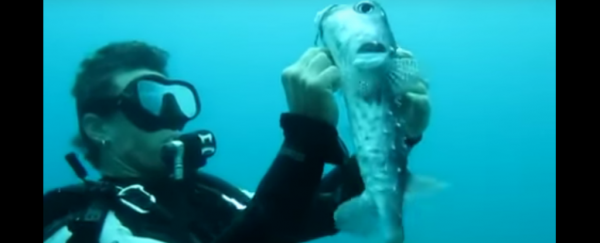If porcupinefish knew what lucky stars are, this one would be thanking them a hundred times over. It's a one-in-a-million diver who would risk getting stuck by one of those spines to yank a very sizeable hook out of a porcupinefish's mouth, so it's pretty great that we get to watch it happen. Uploaded by YouTuber Kye Bolen, the footage shows a diver taking hold of a porcupinefish as he wiggles a hook very delicately from its mouth. The pace is excruciating, but he gets there in the end, and the reaction of the porcupinefish is fascinating.
Often confused for pufferfish because they're both spiky, puffy, and incredibly venomous, porcupinefish belong to a family of medium- to large-sized fish found in shallow temperate and tropical seas all over the world. They're nocturnal and solitary creatures, and tend to hang around in coastal waters around shipwrecks, reefs, and caves - wherever they can find a nice little crevice to hide away in.
While most animals would be happy with just one really effective defense mechanism, porcupinefish get a whole bunch. Not only is their skin covered in long spines to ensure that any attempts to bite or swallow them will come with some serious pain, they've acquired extremely powerful toxins that in some species are present in both their skin and internal organs.
Just like pufferfish, porcupinefish back up their toxic spines with an ability to blow themselves up to about twice their regular size. The reason the diver in the video above was able to gently handle the porcupinefish is because its spines lie flat against its body until it decides to inflate. You'll see near the end of the footage that when the hook is almost out and the diver is really yanking it, the fish starts to panic and inflates itself in response to the perceived threat. The diver has to move his hands up near its head to avoid the now-erect spines.
Porcupinefish are able to inflate themselves thanks to an unusual lack of pleural ribs and a pelvic girdle, which means they can achieve incredible flexibility in their stomachs. This allows them to extend right out when they gulp in air or water. Their stomachs have lost much of their digestive ability, and have basically evolved to become simple, empty sacs.
If spines, toxic flesh, and a huge, ballooning body aren't enough to deter a predator, porcupinefish are also equipped with highly venomous insides. Select organs such as their livers and ovaries are laced with tetrodotoxin, which is an incredibly potent neurotoxin that's also produced by pufferfish, newts, ocean sunfish, and the blue-ringed octopus. Scientists have calculated that it's 1,200 times more poisonous than cyanide.
Despite all that, both the porcupinefish and the diver in the video above came out of their interaction relatively unscathed (it still would have hurt getting that humungous hook out), and our faith in humanity is restored for another day. We never thought porcupinefish could be so adorable.
H/T: Digg
